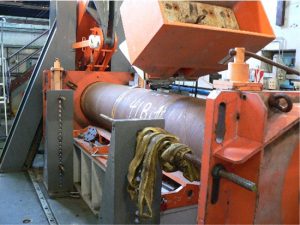
Stress data obtained at the CNBC will be useful to the industry in making hundred thousand-dollar decisions about how to manage pipelines that have sustained mechanical damage, for example, as a result of a backhoe digging in the wrong place.
Source: Canadian Neutron Beam Centre (CNBC)
Contact: cnbc@cnl.ca
North American society today depends critically on reliable sources of fuel for energy production, including a steady flow of oil and gas to the market through pipelines.
In Canada alone, pipelines transport enough fuel per day to drive one million cars for 4,000 km. Canadian pipelines increase public safety by removing the equivalent of 4,200 rail cars from our rail lines or 15,000 tanker trucks from our roads every day.

GdF Suez lab simulates dents produced by a backhoe.
Despite being the safest, most reliable and most cost-effective means to transport oil and gas, when a pipeline failure does occur, it can be damaging to the environment and to the public’s assurance of its safety and security. Pipeline owners prevent failures by using the best scientific methods available to interpret inspection data and inform decisions about, for example, whether to replace a small section of pipeline, which may cost over a hundred thousand dollars.
To solve challenging problems like this, the global pipeline industry pools resources through the Pipeline Research Council International (PRCI), which spends over $10 million per year on research, adding to research funds from government sources such as the U.S. Department of Transportation (DOT) or Natural Resources Canada.
Prof. Lynann Clapham at Queen’s University and researchers from GdF Suez are collaborating to access the CNBC to help interpret pipeline inspection data from a technique called Magnetic flux leakage (MFL). Their research, funded by PRCI and U.S. DOT, seeks to develop a library that maps MFL data to specific kinds of defects and conditions of stress around the defect—factors which influence the likelihood of failure.

A 0.5-m section of
large-diameter pipe
with a gouge nearly
0.4 m in length.
Magnetic flux leakage is sensitive to the loss of metal from corrosion or mechanical damage, which could be caused by a backhoe digging in the wrong place, for example. Thus, GdF Suez produced dents and gouges in full-sized, pressurised sections of pipe, mimicking the damage caused by a backhoe.
Prof. Clapham’s research group mapped the stress around these gouges at the CNBC, and is comparing them to computer stress models and experimental measurements of the MFL signal. The group aims to find correlations that can be used to determine if an MFL inspection signal in the field was produced by mechanical damage, and to estimate the level of risk represented by the damage. That data will be useful to the industry as scientific input into decision-making about how to manage affected pipelines.
